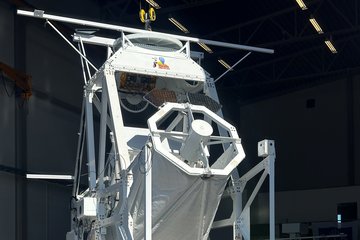All genres
41.
Journal Article
ELF harmonic radiation from the Tromsø heater. Geophysical Research Letters 20, pp. 2243 - 2246 (1993)
42.
Journal Article
EISCAT observations of electron temperature oscillations due to the action of high power HF radio waves. Journal of Atmospheric and Terrestrial Physics 55, pp. 1433 - 1448 (1993)
43.
Journal Article
Introduction to ionospheric heating experiments at Tromsø - II. Scientific problems. Journal of Atmospheric and Terrestrial Physics 55, pp. 601 - 613 (1993)
44.
Journal Article
Introduction to ionospheric heating at Tromsø - I. Experimental overview. Journal of Atmospheric and Terrestrial Physics 55, pp. 577 - 599 (1993)
45.
Journal Article
Anomalous absorption during artificial modification at harmonics of the electron gyrofrequency. Journal Geophysical Research 98, pp. 13627 - 13634 (1993)
46.
Journal Article
VLF heating of the lower ionosphere: Variation with magnetic latitude and electron density profile. Geophysical Research Letters 19, pp. 1747 - 1750 (1992)
47.
Journal Article
Observations of ionospheric modification by the Tromsø heating facility with the mobile diagnostic equipment of IZMIRAN. Journal of Atmospheric and Terrestrial Physics 54, pp. 75 - 85 (1992)
48.
Journal Article
EISCAT observations of large scale electron temperature and electron density perturbations caused by high power HF radio waves. Journal of Atmospheric and Terrestrial Physics 54, pp. 1555 - 1572 (1992)
49.
Journal Article
Comment on ``Stimulated emissions from magnetized and inhomogeneous plasma'' by S. Goodman. Journal Geophysical Research 97, pp. 15057 - 15058 (1992)
50.
Journal Article
Reply (to 'Comment on ``Langmuir Turbulence and Ionospheric Modification'' by P. Stubbe, H. Kohl and M. T. Rietveld' by D. F. DuBois, A. Hanssen and H. A. Rose). Journal Geophysical Research 97, pp. 15067 - 15071 (1992)
51.
Journal Article
Langmuir turbulence and ionospheric modification. Journal Geophysical Research 97, pp. 6285 - 6297 (1992)
52.
Journal Article
ELF radiation from Tromsø ``Super Heater'' facility. Geophysical Research Letters 18, pp. 1035 - 1038 (1991)
53.
Journal Article
On the ELF generation efficiency of the Tromsø heater facility. Geophysical Research Letters 18, pp. 1971 - 1974 (1991)
54.
Journal Article
Long-range detection of VLF radiation produced by heating the auroral electrojet. Radio Science 26, pp. 871 - 879 (1991)
55.
Journal Article
Phase and amplitude perturbations on subionospheric signals produced by a moving patch of artificially heated ionosphere. Journal Geophysical Research 96, pp. 239 - 248 (1991)
56.
Journal Article
New phenomena observed by EISCAT during an RF ionospheric modification experiment. Radio Science 25, pp. 251 - 262 (1990)
57.
Journal Article
Dependence of stimulated electromagnetic emission on the ionosphere and pump wave. Journal Geophysical Research 95, pp. 17233 - 17244 (1990)
58.
Journal Article
Anregung periodischer Magnetfeldschwankungen durch Einstrahlung von amplitudenmodulierten Hochfrequenzwellen in die polare Ionosphäre. Kleinheubacher Berichte 33, pp. 141 - 149 (1990)
59.
Journal Article
Excitation of periodic magnetic field oscillations in the ULF range by amplitude modulated HF waves. Annales Geophysicae 8, pp. 765 - 780 (1990)
60.
Journal Article
The concept of a kinetic transport theory. Physics of Fluids B 2, pp. 22 - 33 (1990)











